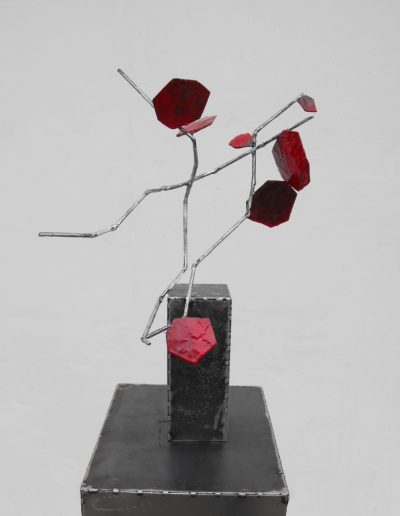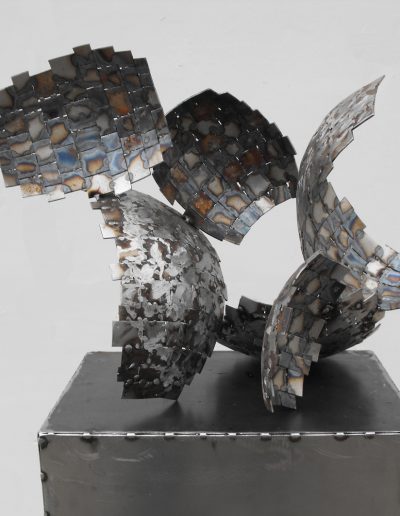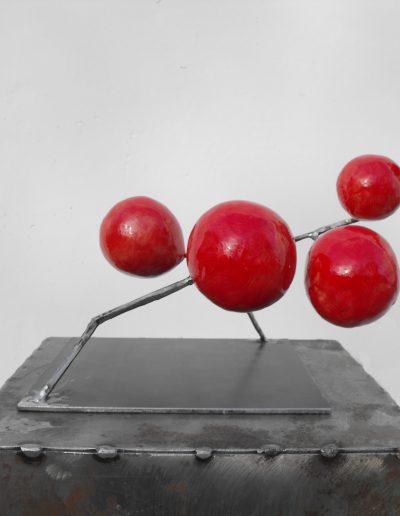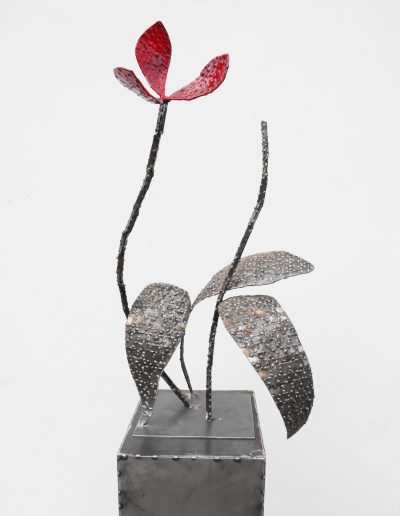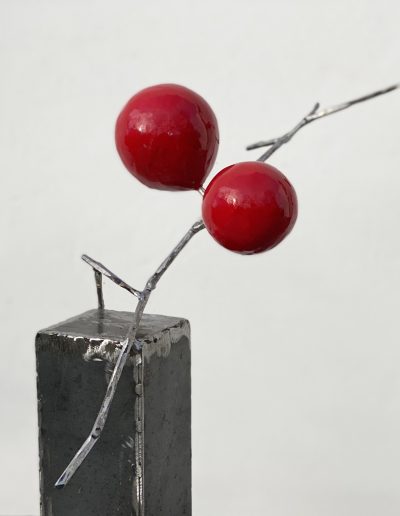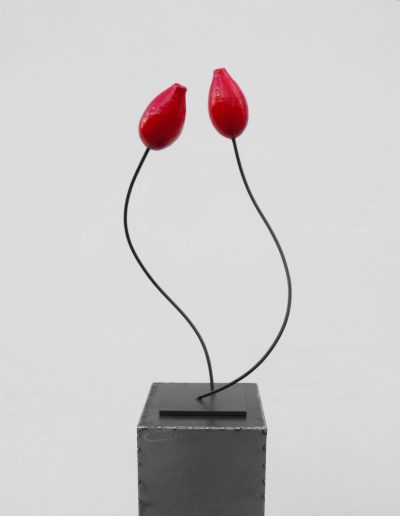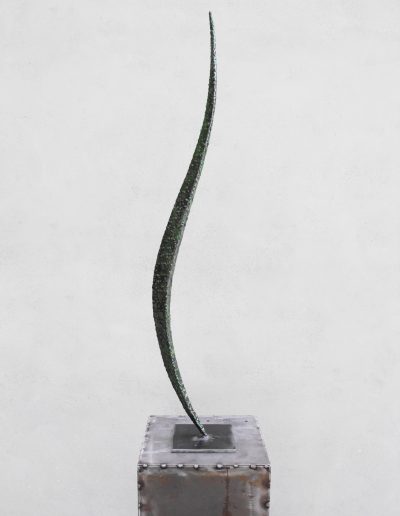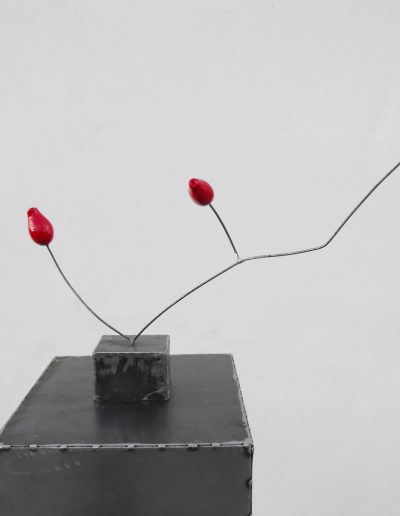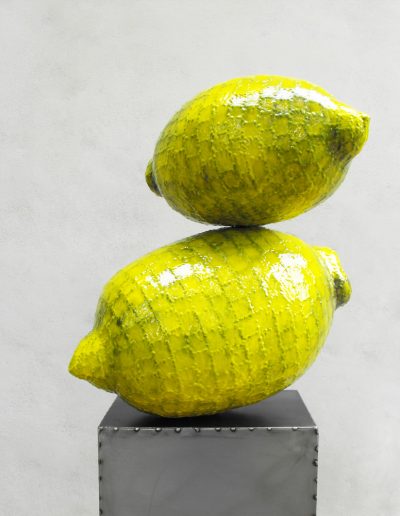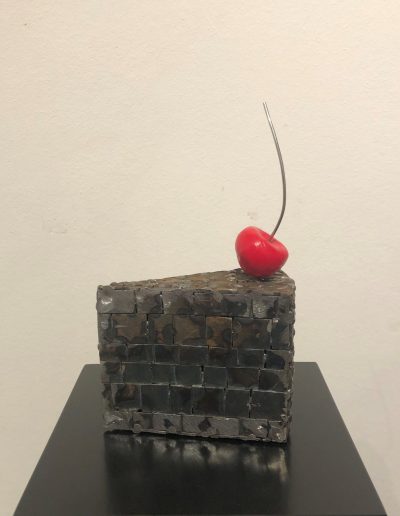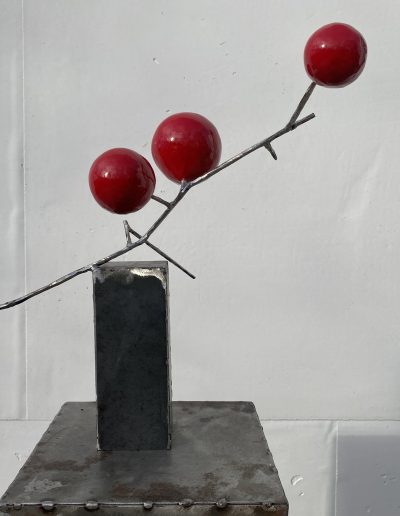Bruno Feger
WORKS // INFO // BIOGRAPHY // EXHIBITIONS // COLLECTIONS
WORKS
ARTIST
Bruno Feger
The monumental blossoms and plants made of steel, wax and resin, which Bruno Feger removes from their actual purpose and familiar form and places in public space and nature, appear imposing, almost fantastic. Isolated as a single plant or brought together in groups, they naturally rise up to the sky here and there like steel. Thus, for example, our gaze follows a steel tube several meters long that rises vertically into the sky in a curved form and yet is completely static. At its tip, two oval-shaped steel blades composed of small material plates unfold. The welds are still clearly visible. The individual particles previously removed from a large steel plate are thus joined together to form a new shape.
“Division and composition are a contradiction, but vital.” This is how Bruno Feger describes the impetus for the production process, which for him has an elementary significance and does not serve solely to complete a work of art, but is itself already part of the work of art. At the same time, this reveals his fascination for contrasts, both in terms of material and work process, as well as in terms of the meaningfulness of his works.
Not least because of the brightly colored material surface, the object explains itself to the viewer as a floral plant. Here, the artist relies entirely on the viewer’s experiential potential and associative abilities, which allow the sculpture its function and meaning. He creates an intense connection between the sculpture and the viewer, which opens up completely new realms of experience for the latter.
Bruno Feger takes the path of confrontation with his works, both in terms of the relationship between viewer and object, and in terms of the relationship between nature and object. After all, if he has formulated his sculptures according to archetypes that can be found in nature, he subsequently restores them to precisely this.
As a kind of exemplar they appear in the outside space. Their material drastically challenges the naturalness that surrounds them, and yet the forms, formed from rigid substance, blend almost vibrantly into the movements of the outside. A foreign body harmonizing with its surroundings, which at the same time seems to bring about unanimity. A contrasting dialogue of duration and transience, reality and fiction, distance and proximity is created.
The viewer, too, can hardly escape this field of tension when confronted with the monumental plants, flowers, and grasses, which completely disregard the usual relations of size and lead him into completely new, unfamiliar perspectives.
Integrated into their respective temporary locations, it seems as if the sculptures were part of the surrounding landscape and had never been moved before. And yet, despite the apparent harmony, the viewer is quickly irritated and begins to question what he sees. Our knowledge of nature and its manifestations makes us immediately understand which plant species are facing us here, even towering over us. The tulip, the rosehip or the simple grasses – they are all familiar to us through their form, color and place in nature. Through these natural forms that are familiar to us, Bruno Feger creates the connection between art and the viewer. We are spontaneously and as if of our own accord drawn very close to the objects, can look at them from all sides, walk around them and even partly through them. At the same time, the artist challenges us. He transports the apparently ordinary plants we are familiar with into oversized forms and lets them grow towards the sky in what is probably their most beautiful growth and with a steely structure, in defiance of all vegetation. In this way, a new world of experience opens up that seems to go beyond what is actually visible.
In the starting point of Bruno Feger’s art almost always seems to be the attempt to put object and sign in a relationship to each other, to connect them with each other but also to exchange them against each other.
He creates his flowers and other plants as ideal images, imperishable as a snapshot in their most beautiful state of growth, recognizable by the viewer even in their abstracted form and color. The symbolic power of the plants themselves, but also that of their color (often the rich red, blue or green) seems to unfold their meaning directly for the viewer:
The healing power of the rosehip, the rich red of the tulips, signaling passion and fertility as well as danger. Or the grass, which is often little noticed in nature by the wayside or under our feet, but here, isolated as a single object, gains the viewer’s full attention and whose color stands equally for hope and growth.
It is the contrasts and contrasts in form and content that make Bruno Feger’s sculptures speak. Transience is brought to a standstill, naturalness is displaced by artificiality, proportions are suspended, the real is elevated to the ideal, reality and realness are questioned. The positioning of the sculptures, which are actually rigid, also initiates movement and opens up a dialogue with the space surrounding them.
Through this idealizing and contrasting mode of representation, as well as their oversized size, the sculptures become striking signs in public space, in the midst of nature, after whose model they were created and in the midst of which they now create a field of tension as contoverses, reformulating the perception of things and at the same time raising existential questions.
In a similar way as Bruno Feger’s plants are taken from their natural destination and isolated in order to function as signs, words or whole parts of sentences are also deliberately removed from their respective linguistic or literary context and placed freely in space as sculptural steel objects. The meaning of the words is usually difficult to decipher, while they play an elementary role in the process of creation, the transformation process from sign to object.
Bruno Feger also experiments here with the relationship between object and meaning. Here it is images that do not immediately evoke an association in us, although in their initial form they are supported solely by their content meaning.
We have to get completely involved in perceiving the forms, the cast of shadows, the movement and the material, without being able to concretize a content-related thought right away.
The artist himself describes the effect of his steel words with the following sentence:
“This veiling of dissimilarity with things, which in turn makes things real.”
Unlike the steel flowers, grasses and plants, here the sign itself is brought to tangible form, the language transformed into a three-dimensional structure, which in this way reaches entirely new levels of meaning.
BIOGRAPHY
1962
born in Haslach in the Black Forest
1982 – 87
Study of architecture, Berlin University of the Arts
1998
Art award of the city of Hanau
2002
Prize of the city of Mörfelden-Walldorf
Lives and works in Eschbach
EXHIBITIONS
SOLO EXHIBITIONS
2020s
Lebendiges Leben: Ein Dialog, Ali Sedri und Bruno Feger, Arthus Galerie Zell
Reflecting Beauty, Isa Dahl und Bruno Feger, Galerie Barbara von Stechow, Frankfurt
Skulpturenpark, Bad Nauheim
2022
Konfrontation Raum, Bruno Feger und Siegfried Felder, Kunstverein Worms e.V.
IN BLOOM, Gruppenausstellung, Galerie Barbara von Stechow, Frankfurt am Main
art KARLSRUHE, Galerie Barbara von Stechow, Frankfurt
2010s
2019
Kunstweg Zell a.H.
2017
Galerie im Prediger, Schwäbisch Gmünd
2015
Goethe-Universität Frankfurt, Campus Westend
Art Fair Cologne, Galerie Barbara von Stechow, Frankfurt
2014
Kunst Zürich, Galerie Barbara von Stechow, Frankfurt
2013
Tal der Musen, Skulpturenweg Hirzbacher Höfe
Hölderlin Porträt Stahlworte, Galerie Netuschil
Skulpturenausstellung Walldorf
2012
Galerie Barbara von Stechow, Frankfurt
2011
Skulptur Bingen
2010
Art Karlsruhe, Galerie Barbara von Stechow
Landesgartenschau Bad Nauheim
2000s
2009
Kunstturm Mücke
Galerie Barbara von Stechow, Frankfurt
Skulpturenpark Heeswijk, Holland
2008
KunstArt Bozen, Kunsthaus Schill, Stuttgart
Kunstverein Laubach
2007
Liste Köln, Galerie Barbara von Stechow
Villa Gans, Kronberg
2006
Villa Haiss Museum für zeitgenössische Kunst, Zell a. H.
Galerie der Stadt Mörfelden – Walldorf
Bauverein AG, Darmstadt
2005
Köln Messe, Köln
Art Karlsruhe, Galerie Barbara von Stechow, Frankfurt
Art Frankfurt, Galerie Barbara von Stechow, Frankfurt
Galerie Netuschil, Darmstadt
Galerie Marie Luise Wirth , Zürich-Hochfelden, Schweiz
2004
Kunsthalle des Galerieverbandes Hessen und Rheinlandpfalz, Frankfurt
Art Frankfurt, Galerie Barbara von Stechow, Frankfurt
Kunstarchiv, Darmstadt
2003
„Schnittstelle“, Galerie Forum, Usingen
„Spiegelungen“, Galerie Raitz von Frentz, Wiesbaden
SkulpturenLandschaft Hamburg, Hamburg
2002
Art Frankfurt, Galerie Barbara von Stechow, Frankfurt
„Die Wasser fließen himmelwärts“, Kunstverein March
2001
Art Frankfurt, Galerie Barbara von Stechow, Frankfurt
2000
„Oh Heimat deine Sterne“, Kunstverein Mittleres Kinzigtal
1990s
1999
Darmstädter Sezession, Darmstadt
Malerei und Skulptur, Kunstverein Passau
1998
„Blüten“, Galerie Barbara von Stechow, Frankfurt
Villa Haiss Museum für zeitgenössiche Kunst, Zell a. H.
1997
„33 Momente des Glücks“, Arthur Andersen, Eschborn
Skulptur von Bruno Feger im E-Werk, Freiburg
1996
„Der Weg zum Kreuz“, Kunstverein Greven
1989/90
»Plastik im Freien«, Kulturamt Stuttgart
Skulpturenpark G. Burk in Bad Nauheim
COLLECTIONS
Sammlung Eva Maria und Morihiro Abe, Meerbusch
Sammlung Ernst & Young, Eschborn
Solvay Deutschland, Hannover
Voswinkel GmbH, Düsseldorf
AMB Generali, Aachen
Evangelische Markuskirche, Butzbach
Rosenmuseum, Bad Nauheim
Sammlung Reutter, Gutach
Sammlung der Stadt Haslach i.K.
DG-Verlag, Wiesbaden
Bauverein Darmstadt AG, DarmstadtSammlung KfW
Bankengruppe, Frankfurt
Sammlung Hoimar von Ditfurth, Bad Homburg
Sammlung Rainer Wild, Heidelberg
Sammlung Edith Ulmer, Frankfurt
Sammlung Christoph Neizert, Marköbel
Sammlung Museum und Galerie im Prediger, Schwäbisch Gmünd
Sammlung Baeck-Strohschein, Bad Homburg
J.W.Goethe Universität, Frankfurt

